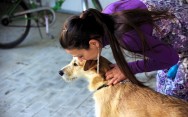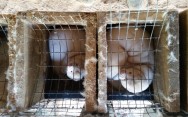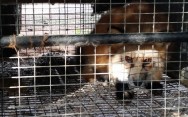Blog Archives
Home -
Archive by category "Trans-Humanist"
On December 2, 2025, Mexico made a historic leap forward for animal rights by amending its
Constitution to include protections for nonhuman animals. This reform is the first of its kind in the
nation. While many countries have animal protection laws, few have elevated the protection of
animals to constitutional status, and even fewer have extended this to cover all species, including
farmed animals. Mexico’s new constitutional changes mark a groundbreaking shift towards treating
animals as beings deserving of legal recognition and rights, regardless of their species.
In most countries, animal welfare laws are selective, often prioritizing companion animals over those
in agricultural industries. In the United States, for example, farmed animals are often excluded from
protections that apply to pets or wildlife. Mexico’s reforms aim to change that by ensuring all
animals, from farmed animals to those kept as pets, are entitled to legal protection. This
approach could set an example for other nations, particularly in Latin America, where animal rights
movements are gaining momentum. However, with Mexico being one of the world’s top producers
of meat and animal products, it is highly probably that economic interests will hinder the
implementation of these reforms. Agricultural lobbyists could easily push back against these laws to try to
protect profits.
One particularly important aspect of the reforms that could have a positive impact on the future is
education. The changes require the inclusion of animal welfare education in Mexican schools. In the
best-case scenario this could influence a new generation that values and understands animal rights.
It could be the first step in changing cultural attitudes towards animals on a larger scale. While the
specific details of this educational shift have yet to be defined, the hope is that it will lead to a
transformation in how Mexican society views and treats animals in the future.
The constitutional amendment represents a step forward in recognizing animals as sentient beings
with rights, but the true test will be in the details. It is unlikely that Mexico will go far enough in
creating strong, enforceable laws that truly afford equal protection to animals. On the other hand,
this victory sends a message about the direction society is capable of going if social imagination can
conceive of animals as equal beings to humans. There are many self-interested forces at work trying
to convince humans that it is too difficult to value animals in parity to ourselves, that there are too
many problems or steps to be taken, and true equality for animals is not possible. Legislation at a
constitutional level proves that changes can be far-reaching and can affect all animals.
At Freedom 4 Animals, our work includes both education and advocacy. Both of these things
contribute to change, as people learn about our fellow inhabitants of this earth and how we can
elevate their status as beings worthy of equal consideration. Please read more about our work to
educate the public and fight for animal freedom.
Despite some positive progress in legislation, puppy mills are still a big source of cruelty and neglect,
a fact that is all too real for thousands of dogs across the United States. The ASPCA’s recent poll
revealed that the most important issue for supporters in 2025 is fighting for stronger legislation to
protect puppy mill victims. Large-scale commercial breeding operations continue to operate under
outdated and inadequate regulations. People are beginning to wake up to the fact that this cruelty is
still legally sanctioned, but we are a long way from liberating dogs from puppy mills.
Puppy mills are notorious for their appalling conditions, with many dogs confined to tiny, wire cages
barely large enough for them to turn around. These facilities, which are regulated by the U.S.
Department of Agriculture (USDA), often fail to meet even the most basic welfare standards. Female
dogs are bred relentlessly, producing litter after litter without adequate time for rest and recovery.
Even with laws on the books, these standards are rarely enforced, and commercial breeders that
neglect their animals continue to operate unchecked.
Even the lucky ones who are adopted and rescued from lives of forced breeding have stories of
trauma, their bodies ageing faster than is normal for a well-cared-for dog. Read about the story of
Gracie, a dog who was rescued after 6 years of breeding 100 puppies:
https://www.humaneworld.org/en/blog/mama-dogs-story-why-we-do-work-we-do-stop-puppy-
mills
There have been recent wins, including the passing of the New York Puppy Mill Pipeline Act in
December 2024. This New York legislation bans the sale of cruelly bred pets in retail stores. The
ASPCA report outlines a commitment to building on this momentum by pushing for similar
legislation in other states in 2025. The ASPCA also advocate for Goldie’s Act, a bill that would require
the USDA to enforce stronger oversight of federally licensed facilities, ensuring more frequent
inspections, intervention for animals in need, and better coordination with local law enforcement.
The road to eliminating puppy mills is long, but with continued advocacy, we can reduce the
suffering of countless animals. The fight is far from over, and it’s imperative that we keep working
together to ensure that no dog ever has to endure the horrors of a puppy mill again.
Please read more on the ASPCA Website: https://www.aspca.org/news/poll-results-revealed-which- animal-welfare-initiative-was-voted-most-important-aspca-supporters
For more information about our work at Freedom 4 Animals to educate the public and push for
animal freedom, please click to read: https://www.freedom4animals.com/the-empathy- program/
|
Tags: Animal Abuse,
Animal Advocacy,
Animal Cruelty,
Animal Freedom,
animal rights,
ASPCA,
Commercial Breeding,
Forced Animal Breeding,
Gracie's Story,
Kevin Boileau,
Nazarita Goldhammer,
New York Puppy Mill Pipeline Act,
Puppy Mills,
USDA
Peanut the Squirrel and Fred the Raccoon were two beloved rescue animals who were euthanized after a raid on their owners’ home by the New York State Department of Environmental Conservation (NYSDEC).
Who is responsible for their deaths? The party directly responsible is the NYSDEC who carried out the raid and the Chemung Health Department (CCHD) Environmental Health Services who ordered the animals euthanized to test for rabies. More generally however, there’s a need to reckon with our collective responsibility for the way human regulations can affect animals’ lives.
Peanut, (otherwise known as P’nut), was a baby squirrel rescued by Mark Longo after his mother was hit and killed by a car. Longo bottle fed and cared for the baby squirrel. Longo says he tried to release Peanut back into the wild but Peanut had become attached to his human carers and returned to their house with a damaged tail. After that, Peanut became a family member. Mark Longo later started an animal rescue shelter and adopted Fred the Raccoon, who was also a victim of the raid.
The raid was a response to complaints about Longo’s animal rescue center and his illegal ownership of P’nut and Fred. It is illegal in New York to keep wild animals as pets. Only licensed wildlife rehabilitators can rescue animals, and only wild animals registered as educational animals can be kept as pets. Mark Longo said he was in the process of filing the paperwork to apply for a wildlife rehabilitation license and to register Peanut and Fred as educational animals. He indicated that the process was slow and he needed more guidance from the DEC.
The paperwork involved in registering for these official designations is burdensome, and many wildlife lovers may not be informed about how to care for animals that they rescue from the wild.
Peanut and Fred were euthanized on the authority of the CCHD because of rabies concerns. Even though squirrels aren’t known for carrying rabies, Peanut’s proximity to Fred the raccoon (racoons are known to carry rabies) prompted the euthanization of both animals after Peanut bit through the gloves of someone carrying out the raid. Both animals were found to be free of rabies.
Animal and human interactions happen frequently. All animals are known to interact with each other in nature. Yet animals are in danger of being euthanized every time they take a perfectly logical step of seeking food from human property, or of allowing a human to take care of them when they are in need.
What started with the death of Peanut’s mother due to human causes (the car that hit her) ended with the death of Peanut because of human laws that are indifferent to animal needs and behaviors. In both cases, human standards and technology are imposed on animals and encroach in animal environments. Animals who get in the way become the victims.
There are many examples of animals taking care of other animals in the wild, particularly baby animals. When humans do the same there is little understanding for this process. There should be a protocol to help humans care for animals that are wounded or sick, or to raise babies who can no longer survive in the wild. Right now, the protocols have no room for understanding that animal-human interaction does happen naturally, and that animals should not suffer as a result.
Animals are frequently euthanized due to the threat of rabies. Their heads are cut off to examine their brains. Rabies is a deadly disease and animals are euthanized out of an excess of caution, but so often these tragic and violent deaths are a result of inadequate protocols and clumsy investigations surrounding animals that get close to humans. There is currently no ante mortem test for rabies for animals.
Like so many stories about animal deaths, the death of Peanut the squirrel and Fred the Raccoon is a story about human indifference to animals, and indifference to the roles they play in our lives. It is natural for humans to interact with animals. We are animals too, after all.
Animal control laws involve brutality and a lack of nuance. Just like with human first responders, animal first responders often react with violence. Instead of social workers humans get the police who arrive with guns. Instead of care and due process, animals are sent to their death just because they get close to humans.
Violence is a direct result of a lack of care for the individuals involved in the situation and the specifics of each person and each life, whether human or animal. The first response to animals who choose to live with humans should not be violence. There needs to be a slower more responsive process that cares for everyone involved.
|
Tags: Animal Conflict,
Animal Euthanasia,
Animal Law,
Animal Lives,
animal rights,
Freedom for Animals,
Human Animal Conflict,
Kevin Boileau,
Nazarita Goldhammer,
Peanut the Squirrel,
Rabies,
Raccoon,
Rescue Animal,
Squirrel,
Transhumanism,
Wild Animals
A campaign is underway to get Congress to pass the SAFE Act, which has been stalled in congress since last year. Click on the link to sign the petition to stop horses being exported abroad for slaughter:
The US has banned the slaughter of horses at home. However, this ban means nothing while it’s still legal to transport horses thousands of miles to be slaughtered in the horsemeat trade, their last moments spent in the “kill box,” frightened and panicked before being chopped to bits. Wild horse slaughter in the U.S. was shut down in 2007 but the export industry still sends 20,000 horses every year to their deaths in Canada and Mexico. Not only this but the horses first endure long, gruelling journeys in cramped and cruel conditions before they are killed. According to a 2023 report from the American Journal of Veterinary Research, the horse export industry thrives and generates around $500 million a year,
With all the panic surrounding unverified claims that cats and dogs are being eaten in the United States, it’s a good time to draw attention to the plight of horses. The SAFE Act, or Save America’s Forgotten Equines Act (HR 3475/S 2037) is a bill that animal activists have been pushing to get passed for decades. In its current form the SAFE Act amends the 2018 Dog and Cat Meat Trade Prohibition Act to add equines to the list of animals prohibited to be exported slaughter.
Polls show that 83% of Americans oppose horse slaughter. Yet thousands of horses each year face a horrible ending to their lives. The meat industry lobbies to protect the export of horse slaughter by claiming that if horses are not slaughtered, there will be more neglect and nowhere to rehome horses. Contrary to these claims, the export of horses has actually decreased over the years and shelters are ready to rehome horses, the majority of whom can live out happy and productive lives.
Horses are incredibly sensitive animals who need freedom of movement and family bonds with their fellow horses. Capturing them and transporting them for 24 hours to be killed is not only murder, it is prolonged torture.
As well as a petition there is also a website that makes it easy for you to write to your member of congress to pressure them to sponsor and pass the SAFE Act.
At Freedom 4 Animals, we have done extensive work to preserve the right of free-roaming horses to remain with their families and negotiate and advocate to protect horses from mistreatment, neglect and cruelty, as well as education and working with policy-makers and NGOs on legislation and initiatives to support and protect the freedom of horses.
Please read more about the work we do on behalf of horses and other animals.
After Kristy Noem boasted about shooting her puppy in cold blood, now there are reports that right
wing figurehead Kevin Roberts told several people that he killed a neighbor’s dog with a shovel to
stop her from making noise.
The dog, Loca, disappeared in 2004, the year Roberts was alleged to have boasted about killing her.
It’s impossible to verify whether the story is true or not but there is evidence that casts suspicion on
Roberts.
The chair of the history department at New Mexico State University where Roberts worked recalled hearing the story, as did two other people, a professor andher spouse and three others who said they heard the account at the time from others. Roberts hadn’t said the dog was a danger, according to these reports, he had just said the dog was loud, and he appeared proud of what he had done.
Roberts named the neighbor who owned the dogs, Daniel Aran, and claimed that animal control had
come to rescue multiple dogs from the property, casting himself as a concerned neighbor, as well as
citing that Aran went to prison for cocaine distribution. Aran and his mother denied that animal
control had come to rescue any dogs. They both said they had a dog go missing around 2004, the
year when Roberts boasted about killing a dog. They spoke with affection about their dog, “my little
Loca.” Aran said Loca had been his favorite dog. “She was a little, little thing like this,” Aran said.
“She was a tiny, cute little thing.”
Aran said he and his mother went searching for the dog but could never find her, and dog catchers
weren’t able to find her either.
We will never know what happened to little Loca, or what she had to endure in her final moments.
Despite concerning evidence, this cold case will never go investigated and little Loca’s mystery will
not be solved. Any justice that may be due to her will not be served.
Although we have no way of knowing whether these allegations are true, it’s a chilling story that
should serve as a reminder that animals do not receive the same treatment in the criminal justice
system that humans do. Loca deserved better than this.
At Freedom 4 Animals we work with lawmakers, nonprofits, animal rights groups, and individuals to
seek justice for animals and their human custodians who have been harmed, and to advocate for
animal rights within the criminal justice system and beyond. We work to educate the public and
anyone who is interesting in learning about animal rights about the role of animals in society and
how we can re-address those roles to achieve freedom and equality for animals.
To learn more about how animals are treated differently in the criminal justice system and how
violence to animals predicts other forms of violence, please visit the resources on our website.
It’s not just humans who use medicines or are drawn to wild plants to cure ailments. Animals are
known to self-medicate when they are ill, wounded or for stress and sadness. This
phenomenon, known as Zoopharmacognosy, has been observed in many species of animals. It
reveals how animals interact with their environment in a way people have written off as
exclusive to human science and medicine.
One common example is when dogs and cats eat grass to induce vomiting. There are many
other examples of animals using medicine in sophisticated ways. For example, apes have been
observed isolating the medicinal parts of plants by tearing off leaves and stems and taking them
internally or applying the pant to their wounds. Research in lambs has shown that animals can
learn to use medicine by observing the effects of certain plant foods. Animals eat plants to expel
parasites, get nutrients missing from their diets, and induce labor, among other things.
An Indonesian male orangutan named Rakus was observed applying plant sap and crushed
leaves to a wound on the “flange” surrounding his face, as a poultice. The plant, known locally
as akar kuning (Fibraurea tinctoria), is an Asian plant known for its antibacterial, antifungal, anti-
inflammatory and pain relief properties. Rakus was applying plant medication externally for
healing in the same manner that humans used this traditional medicine.
Andrea DiGiorgio, a biological anthropologist at Princeton University, noted that animals don’t
need to understand everything about the medicinal properties of a plant to be able to utilize the
resources in their environment in an intelligent way. DiGiorgio said: “I think this really speaks to
the intelligence that all animals have to utilize what works for them.”
Humans assume that the taxonomy of human knowledge accumulated through language and
writing gives us superior intelligence and understanding of our environment, but this speaks to
the advantages of human technological development rather than intelligence itself. This is
called Speciesism; and carries with the idea that humans are at the top of the hierarchy and
have the greater moral value.
Animal intelligence is rich and in tune with its environment. Often humans are looking in the
wrong places when they search for animal intelligence and knowledge, basing it on concepts of
intelligence that have been imposed by human and Western perspectives. If we observe
animals in their environment, we can see what we have missed. Animals often lead humans to
medicinal plants, water and shelter. Their remarkable senses and intelligence are not
meaningless tools that assist human technology, they should be respected in their own right.
South Dakota governor Kristi Noem has made headlines for boasting that she shot and killed her dog
in cold blood. Noem’s story was intended to paint her as a “no-nonsense” person who had no
problem doing what was necessary. In the same chapter, Noem also wrote about how she shot her
goat in cold blood. Public opinion shows that this has not worked out in her favor. The cold-blooded
killing of a companion animal who relied upon and trusted a human, apparently doesn’t look that
good to the public.
Dogs are human beings’ closest companions and our history has been symbiotic with them for
Millennia. Yet dogs are often the first victims of humans’ failure to take responsibility for this
relationship, as when dogs are euthanized if they attack another animal or a human, or appear to
pose a threat to property and safety. Poor training by human owners and misunderstanding of their dog companions instill trauma and aggressive behavior resulting in the dog’s misbehavior or failure to live up to human expectations.
In her autobiography, Kristi Noem shared how she shot a 14 month old wirehaired pointer named
Cricket who had come to her family with behavioral problems. Noem went as far as to say that she
“hated” the dog. She made no attempt to deal with her own feelings. Instead, her dog Cricket,
immediately became responsible for how she felt, justifying Noem’s execution of the dog. The story
was intended to convey that Noem was a tough person who understood life in rural America. Her
lack of remorse for the killing simply revealed that Noem didn’t care about the dog’s life.
Noem shot her dog Cricket after Cricket prematurely chased birds on a pheasant hunt, then jumped
out of Noem’s truck and mauled chickens on a neighbor’s property. Cricket was free to attack the
chickens, because Noem had failed to secure Cricket in the truck. Successful dog trainers and experts
agree that a dog’s behavior and conduct is the responsibility of the owner, and dogs who misbehave
can behave better with different interventions and understanding.
People who have dogs and other animals as companions have a responsibility to
their pets to act with empathy and patience. Neglect and cruelty affect a dog’s behavior as much as
they do humans. At 14 months old, Cricket was a young dog, a puppy, who deserved care and
guidance. Instead, her life was cut short by her care takers disregard for her life.
The backlash against Noem’s story shows that people will no longer accept a narrative that
blames animals for human issues. We must make a choice to extend our compassion to
other animals, beyond companion animals like cats and dogs. Cricket made headlines, but Noem also
shot her goat. No animal should have to take responsibility for an abusive human’s behavior by
paying the ultimate price.
The Miami-Dade commission has served eviction papers to the Dolphin Company, the owners of the Miami Seaquarium, after the company presided over severe neglect and poor conditions for animals in their care for many years. The Miami-Dade commission has ordered the Dolphin Company to vacate the premises by the 21st of April 2024. The commission’s letter cited violations of the lease agreement which included “not just a default, but a complete disregard for the safety of the animals housed on the premises.”
The history of the park is one of sadness, neglect, cruelty and enslavement for animals. The park’s history as an amenity for humans on the other hand, is one in which it enriched a private company and in the park’s earlier years was the third largest contributor to Miami-Dade County’s revenue through lease and tax payments.
The park is behind at least $180,000 in rent, which is one reason for the Miami-Dade commission’s decision. The decision was also motivated by the park’s numerous USDA violations and the loss of its Humane Society of America certification. Animal rights organizations have spoken out against the facility for years, in some cases managing to rescue animals, such as a pair of manatees, Romeo and Juliet. At least 120 dolphins and whales have died in captivity at the park. A dolphin named Sundance recently died shortly after a USDA inspection, where it was noted that the dolphin had “signs of gastric distress.” Federal inspections showed that the park’s infrastructure was deteriorating. A dolphin was found with a two-inch nail in its throat. Another dolphin was found with a broken metal bolt in its mouth.
One of the park’s major problems was that it couldn’t keep staff. Multiple staff resigned at the conditions of the park, and some alleged retaliation when they tried to speak up against the conditions. Due to money problems and difficulty retaining staff, the park didn’t have enough veterinarians to attend to the animals. The veterinary lab lacked basic tools and the animals were denied surgery, including a sea lion with eye pain, who stopped eating. One of the park’s animals, an Orca named Tokitae, gained recognition for all the wrong reasons, because the tank she was forced to live in was the nation’s smallest tank. Since coming to the world’s attention, Toki, also known as Lolita, has died.
Why did it take so long for the neglect to be put to an end? There is a bureaucratic process that has to happen to hold such facilities accountable. The park was known to be an unhealthy and cruel place for animals to live for decades. Attention wasn’t focused on the park soon enough because parks like these were for many years deemed to be acceptable entertainment and education for humans. The roles of animals at these parks, who are forced to perform for humans, and who are kept in restrictive conditions and separate from family members, were not questioned. It’s now time to question the rationale for keeping animals in these facilities. There may be some conservation reasons for keeping some species of animals captive, but even then, keeping animals in captivity, where they can be exploited, should be viewed with public skepticism and treated as a last resort.
|
Tags: Animal Neglect,
animal rights,
Animals in Captivity,
Dolphin,
Kevin Boileau,
Marine Animals,
Marine Park,
Miami Seaquarium,
Nazarita Goldhammer,
Orca,
Toki the Orca,
Whale
The death of New York’s beloved owl Flaco was a tragic event that drew attention to the way in which a city-dwelling bird’s life can be tragically cut short. The cause of death? It seems that Flaco died after a collision with a building. Flaco’s death was also attributed to 4 kinds of rat poison that were found in his system. Additionally, he was also found to have a severe case of “pigeon herpesvirus” from eating feral pigeons. Toxicology also showed a breakdown of the pesticide DDT, but the levels of the pesticide were not significant enough to cause his death. The rodenticide and virus were both capable of causing severe illness, according to Dr. Paul Calle, chief veterinarian for the Wildlife Conservation society, though it’s unclear which one was responsible for the bird’s death. Flaco’s ultimate cause of death, a collision with a building, would likely have been caused by the bird flying disoriented while he was suffering from illness and poisoning.
Bird collisions are an incredibly common cause of death for birds. They are the second most common cause of death after domestic cats. Collisions with building glass kill between 90,000 and 230,000 migrating birds in New York City each year, according to Audubon NYC’s research. In addition, birds that dwell in big cities have much more contend with, as they have to deal with toxic pesticides commonly used by private homeowners in big cities like New York City. Wild Bird Fund director Rita McMahon said that rodenticide is to blame for 84% of the deaths of birds that they encounter, and that the poisons can stay in a bird’s system for up to 100 days.
Flaco was a Eurasian eagle-owl that escaped the Central Park Zoo after someone cut his cage’s stainless steel mesh. The Zoo attempted to recapture Flaco, but he began to improve his hunting skills and gain independence, so the Zoo were not able to entice him back with food.
Sightings of Flaco began to be common. New Yorkers celebrated the bird’s presence and his successful bid to live in the wild. The Central Park Zoo cautioned that Flaco might be endangered by eating a poisoned rodent or might prey on sensitive species. Flaco seemed to be doing well, but then in February 2024, a fallen owl was reported to the Wild Bird Fund, and the owl was confirmed to be Flaco. New Yorkers mourned his death and created a memorial to Flaco at the base of his favorite tree in Central Park.
Flaco’s death was a tragedy, but his life was an inspiration. Though he was safe at the Zoo, he followed his natural instinct for freedom and lived a life of independence before he died. His death has focused attention on the issue of bird safety in cities, and what humans can do to make cities safer for birds. New York Senators have renewed a push to pass the Dark Skies Act and renamed the Bird Friendly Buildings Act the FLACO Act. These pieces of legislation will require state owned buildings to make bird friendly provisions in their architecture and to reduce lighting at night, which has been shown to disorient night migrating birds that may fly into cities and die by collision. Birds face a host of threats in cities, including bird collisions, habitat loss, and poisoning by pesticide or rodenticide.
Flaco the owl was an animal who stood out and reminded city dwellers that animal lives have meaning. With the publicity around his death, now is a good time to push local legislators to take steps to introduce legislation to make cities more bird friendly. You can also reach out to your local bird conservation societies to see how you can join the effort to protect birds in cities.
In an exciting breakthrough for research in animal communication, the SETI institute managed to
have the first ever conversation with a humpbacked whale. The SETI institute began as a NASA
research program to understand and search for life beyond earth. The Whale-SETI team is using the
mathematics of information theory to understand terrestrial, non-human communication as a way
to develop filters to apply to any communication with extraterrestrial life.
Humpback whales are social and intelligent creatures who make tools and communicate with songs
and social calls. The Whale-SETI team has been studying humpback whale communication, which
include “contact calls” that whales use to communicate their presence to other whales. The team of
scientists from the SETI Institute, UC Davis and the Alaska Whale Foundation played the contact calls
into the sea via an underwater speaker, and a humpback whale named Twain approached and
circled the team’s boat while responding in a style that matched the original contact signal. The
researchers managed to have a 20 minute conversation with Twain. It is the first known
“conversation” between humans and humpback whales. Humpback whales also display non-audio
communicative behavior when they blow bubble rings in the presence of humans.
Whale SETI may be viewed as a springboard for communicating with extraterrestrial life. However
communication with animals could have more immediate benefits for animals in our world, right
now. Whales are one of the marine creatures who are profoundly affected by human activity. Whale song is disrupted by the noise of ships. If we can communicate with non-human animals our decision making should consider them as equal participants.
Humans have erroneously viewed human communication as synonymous with superior intelligence.
Without the ability to communicate with other animals and with a so-called superior intelligence
human activity has rampaged throughout animal habitats without the consent of animals. Every step
towards understanding animal intelligence and communication provides further evidence that these
assumptions are wrong. Scientific knowledge should not dictate our respect for non-human animals,
however scientific discovery can provide a basis for progressive animal rights policy and zero
tolerance for cruelty towards non-human lives.
|
Tags: Animal Communication,
Animal Habitats,
Animal Intelligence,
animal rights,
Humpbacked Whale,
Kevin Boileau,
Marine Animals,
Nazarita Goldhammer,
Transhumanist,
Whale Communication,
Whale Song








Social Media